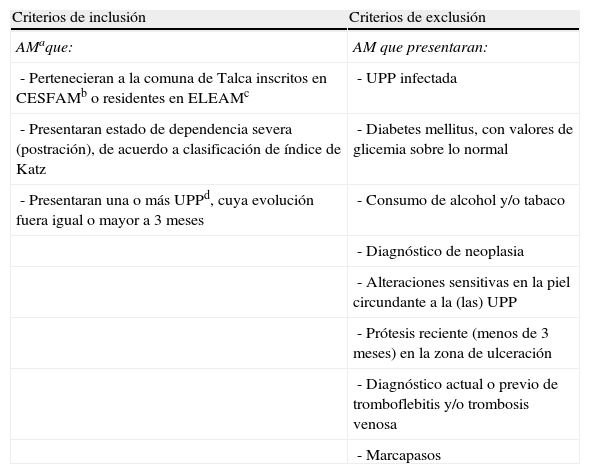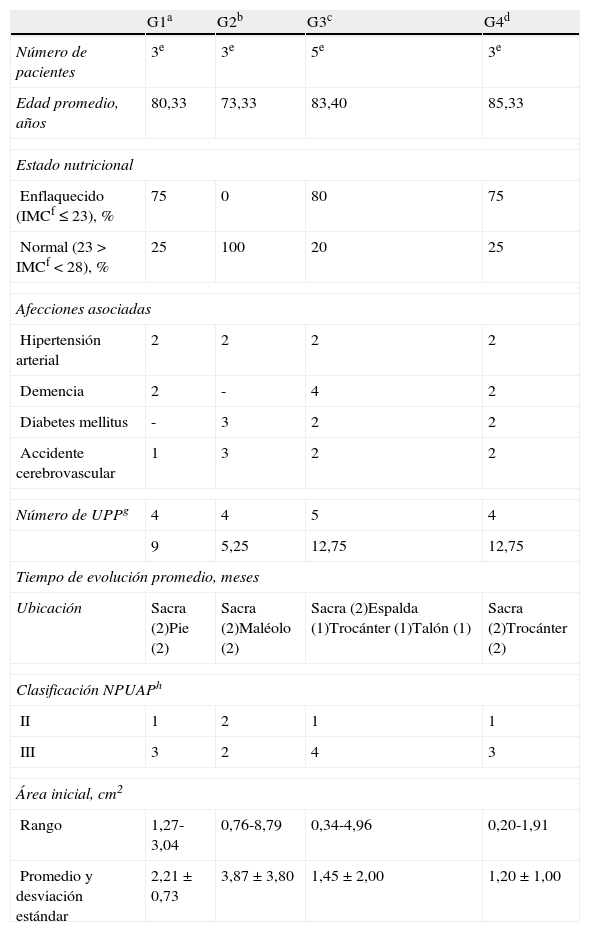En Chile se ha observado que el 50% de las personas que tienen úlceras por presión (UPP) corresponden a adultos mayores (AM). Considerando que esta población muestra un crecimiento sostenido, se hace importante buscar alternativas de solución. Por ello, la presente investigación busca comprobar los efectos de la terapia ultrasónica en el tratamiento de las UPP.
Material y métodosSe intervinieron a 12 AM (17 UPP) provenientes de los centros de salud familiar y hogares de larga estadía de Talca durante 8 semanas, dividiéndolos en 4 grupos (control, luz ultravioleta-C y ultrasonido con densidad energética de 10 y 20J/cm2). Se evaluó una vez por semana el área de las UPP y el puntaje obtenido en el diagrama de valoración de heridas, para comparar sus valores finales, además de estimar tasas de recuperación semanal y final a partir de ellas.
ResultadosTodos los grupos mostraron una disminución de áreas y puntajes, siendo los que recibieron terapia ultrasónica quienes presentaron los mayores cambios, sin embargo, estos no fueron significativos con Kruskal-Wallis. La prueba de Wilcoxon mostró diferencias significativas de área para todos los grupos, y de puntaje solo para el grupo 2 (p<0,05).
ConclusiónSe observaron tendencias que indican que el ultrasonido junto a la radiación ultravioleta-C aceleran el proceso de reparación, pero sin resultados significativos, probablemente por el reducido tamaño de la muestra. Se sugiere realizar nuevos estudios que incorporen más sujetos y así dilucidar la interrogante presentada en la investigación.
In Chile, it has been observed that 50% of the people who have pressure ulcers (PU) are elderly adults (EA). Because this population is showing sustained growth, it would be important to seek solution alternatives. Thus, this study aims to ascertain the effects of therapeutic ultrasound (TU) on the PU healing process in the elderly with severe dependency.
Material and methodsTwelve EA (17 PU) from the CESFAM (Family Health Center) and long-stay Nursing Homes from Talca City were treated for 8 weeks. They were distributed into 4 groups (control, ultraviolet therapy and UT with 10 and 20J/cm2 of energy density). The PU area and the score on the wound assessment diagram were evaluated once a week in order to compare their final values. Weekly and final recovery rates were also calculated from them.
ResultsAll the groups showed a decrease of areas and scores. The TU group showed the greatest changes, however, these changes were not significant by the Kruskal-Wallis test. The Wilcoxon test (P<.05) showed significant differences between all the groups between the initial and final values for the area variable, however, the differences of score (P<.05) were only significant for group 2.
ConclusionTendencies were observed that indicate that the ultrasound together with ultraviolet C radiation accelerate the healing process. However, the difference was not significant, probably because of the small sample size. Thus, new studies are recommended that include more subjects in order to elucidate the question arising in our research.
Artículo
Comprando el artículo el PDF del mismo podrá ser descargado
Precio 19,34 €
Comprar ahora
















